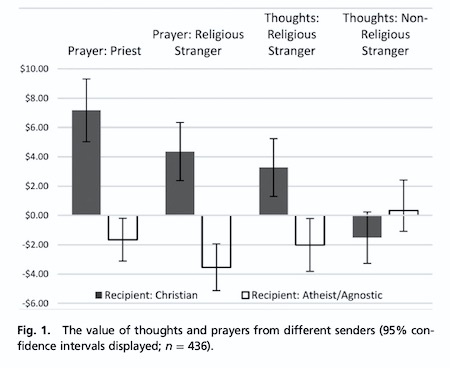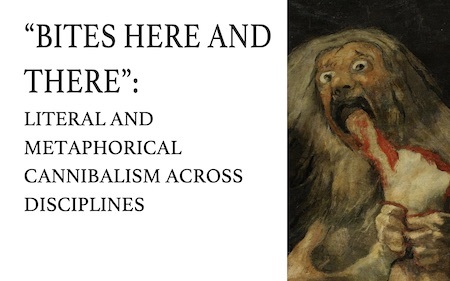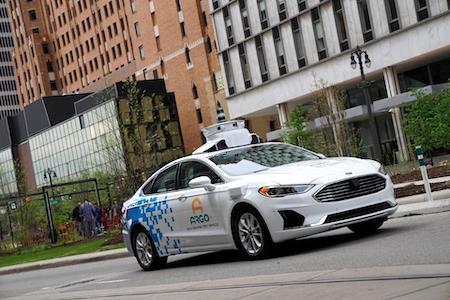Marc Abrahams's Blog, page 137
September 19, 2019
Program details from last year’s cannibalism conference
Here’s the program (downloadable!) from last year’s cannibalism conference at the University of Leeds.
The lunch break was from 12:45-13:45.

September 18, 2019
Evaluating the Value of Thoughts and Prayers [study]
What is one to think about words about thoughts about prayers and thoughts? A new study tries to tease out the answer.
The study is: “The Value of Thoughts and Prayers,” Linda Thunström and Shiri Noy, Proceedings of the National Academy of Sciences, epub 2019.

The authors, at the University of Wyoming, explain:
“A standard response of both policy makers and private citizens to hardships—from natural disasters to mass shootings—is to offer “thoughts and prayers.” Critics argue that such gestures are meaningless and may obstruct structural reforms intended to mitigate catastrophes. In this study, we elicit the value of receiving thoughts and prayers from strangers following adversity. We find that Christians value thoughts and prayers from religious strangers and priests, while atheists and agnostics are “prayer averse”—willing to pay to avoid receiving prayers. Furthermore, while indifferent to receiving thoughts from other secular people, they negatively value thoughts from Christians.”
(Thanks to Mason Porter for bringing this to our attention.)

September 17, 2019
Seeing Spider/Antman Movies Lessen Fear of Bugs?
What power over the minds of humans lurks in bug-human-hybrid superhero movies? One study, at least, asks that question.
The study is: ” ‘Spidey Can’: Preliminary Evidence Showing Arachnophobia Symptom Reduction Due to Superhero Movie Exposure,” Yaakov S.G. Hoffman, Shani Pitcho-Prelorentzos, Lia Ring, and Menachem Ben-Ezra, Frontiers in Psychiatry, epub 2019. The authors, at Bar-Ilan University and Ariel University, Israel, explain:
“Fear of insects, mainly spiders, is considered one of the most common insect phobias. However, to date, no conducted studies have examined the effects of phobic stimulus exposure (spiders/ants) within the positive context of superhero movies, such as Spider-Man or Ant-Man. A convenience sample of 424 participants divided into four groups watched different clips. Two intervention groups (Spider-Man/Ant-Man) and two control groups (Marvel opening/natural scene) were measured twice (pre–post intervention)…. Reduction in phobic symptoms was significant in the Spider-Man and Ant-Man groups in comparison to the control groups. Seven-second exposure to insect-specific stimuli within a positive context reduces the level of phobic symptoms.”

September 16, 2019
Recent progress in cat-video studies
The first peer-reviewed academic study to investigate and document the internet’s cat-video-proliferation-phenomenon might well [we think] be :
● Do Cats Know They Rule YouTube? Surveillance and the Pleasures of Cat Videos by Radha O’Meara, in the M/C Journal, Vol. 17, Issue 2, 2014.
Since then, the prevalence of scholarly investigations which reference internet cat videos has not abated. Here’s a partial list [no particular order] :
● Emotion regulation, procrastination, and watching cat videos online: Who watches Internet cats, why, and to what effect? Computers in Human Behavior, Volume 52, November 2015, Pages 168-176.
● It’s Not All Cat Videos : Moving beyond legacy media and tackling the challenges of mapping news values on digital native websites Digital Journalism, Volume 6, 2018 – Issue 8.
● Cat Videos and the Superflat Cinema of Attractions, Film Criticism, Volume 40, Issue 2, July 2016.
● Not Just Silly Cat Videos: Exploring Student Knowledge Sharing via Social Media Association for Information Systems, Conferences, AMCIS2015 , ISEdu, 6.
● What can science researchers, practitioners learn from the success of cat videos? CSA News (Crop Science America), Oct 2017.
● A Note From the Digital Scholarship Editor: Digital Media Scholarship—Beyond Viral Cat Videos Journal of Family Theory, Volume 7, Issue 3.
● QoE matters more than QoS: Why people stop watching cat videos IEEE INFOCOM 2016 – The 35th Annual IEEE International Conference on Computer Communications.
[Research research by Martin Gardiner]

September 14, 2019
TODAY: The Ig Informal Lectures (& webcast) at MIT
Most of the new Ig Nobel Prize winners will give free public talks TODAY, at MIT (the Massachusetts Institute of Technology). It starts at 1:00 pm (US eastern time).
Admission is free. But seating is limited, so you might want to arrive a bit early.
The lectures will be webcast here at Improbable.com (see below)
Saturday, Sep 14, 2019, 1:00 pm
MIT—building 10, room 250
It’s a half-afternoon of improbably funny, informative, informal, brief public lectures and demonstrations:
The new Ig Nobel Prize winners will attempt to explain what they did, and why they did it.
Some past winners will return, to share their adventures. This year there will be a demonstration by Kazutaka Kurihawa and Koji Tsukada (acoustics prize, 2012) of a new, improved (and larger!) version of the Speech Jammer, the machine that disrupts talking.
Winners will be available for audience members to chat with, both before and after the lectures.
The Ig informal Lectures are a free event, organized in cooperation with the MIT Press Bookstore.

September 13, 2019
Watch the Full Ig Nobel Ceremony
The 29th First Annual Ig Nobel Prize ceremony was a riotous festival of scientific fun! Watch the full ceremony below!
Thanks to everyone who watched, attended, threw paper planes, tweeted and otherwise joined in the fun!

September 12, 2019
Announcing the 2019 Ig Nobel Prize Winners
The 2019 Ig Nobel Prizes were awarded at the 29th First Annual Ig Nobel Prize ceremony, on Thursday, September 12, 2019, at Harvard’s Sanders Theatre. The ceremony was webcast.
The 2019 Ig Nobel Prize winners
MEDICINE PRIZE [ITALY, THE NETHERLANDS]
Silvano Gallus, for collecting evidence that pizza might protect against illness and death, if the pizza is made and eaten in Italy.
REFERENCE: “Does Pizza Protect Against Cancer?“, Silvano Gallus, Cristina Bosetti, Eva Negri, Renato Talamini, Maurizio Montella, Ettore Conti, Silvia Franceschi, and Carlo La Vecchia, International Journal of Cancer, vol. 107, no. 2, November 1, 2003, pp. 283-284.
REFERENCE: “Pizza and Risk of Acute Myocardial Infarction,” Silvano Gallus, A. Tavani, and C. La Vecchia, European Journal of Clinical Nutrition, vol. 58, no. 11, November 2004, pp. 1543-1546.
REFERENCE: “Pizza Consumption and the Risk of Breast, Ovarian and Prostate Cancer,” Silvano Gallus, Renato Talamini, Cristina Bosetti, Eva Negri, Maurizio Montella, Silvia Franceschi, Attilio Giacosa, and Carlo La Vecchia, European Journal of Cancer Prevention, vol. 15, no. 1, February 2006, pp. 74-76.
WHO ATTENDED THE CEREMONY: Sylvano Gallus.
MEDICAL EDUCATION PRIZE [USA]
Karen Pryor and Theresa McKeon, for using a simple animal-training technique— called “clicker training” —to train surgeons to perform orthopedic surgery.
REFERENCE: “Is Teaching Simple Surgical Skills Using an Operant Learning Program More Effective Than Teaching by Demonstration,” I. Martin Levy, Karen W. Pryor, and Theresa R. McKeon, Clinical Orthopaedics and Related Research, vol. 474, no. 4, April 2016, pp. 945–955.
BIOLOGY PRIZE [SINGAPORE, CHINA, AUSTRALIA, POLAND, USA, BULGARIA]
Ling-Jun Kong, Herbert Crepaz, Agnieszka Górecka, Aleksandra Urbanek, Rainer Dumke, and Tomasz Paterek, for discovering that dead magnetized cockroaches behave differently than living magnetized cockroaches.
REFERENCE: “In-Vivo Biomagnetic Characterisation of the American Cockroach,” Ling-Jun Kong, Herbert Crepaz, Agnieszka Górecka, Aleksandra Urbanek, Rainer Dumke, Tomasz Paterek, Scientific Reports, vol. 8, no. 1, 2018: 5140.
WHO ATTENDED THE CEREMONY: Tomasz Paterek, Herbert Crepaz, Rainer Dumke.
ANATOMY PRIZE [FRANCE]
Roger Mieusset and Bourras Bengoudifa, for measuring scrotal temperature asymmetry in naked and clothed postmen in France.
REFERENCE: “Thermal Asymmetry of the Human Scrotum,” Bourras Bengoudifa and Roger Mieusset, Human Reproduction, vol. 22, no. 8, 2007, pp. 2178-2182.
CHEMISTRY PRIZE [JAPAN]
Shigeru Watanabe, Mineko Ohnishi, Kaori Imai, Eiji Kawano, and Seiji Igarashi, for estimating the total saliva volume produced per day by a typical five-year-old child
REFERENCE: “Estimation of the Total Saliva Volume Produced Per Day in Five-Year-Old Children,” Shigeru Watanabe, M. Ohnishi, K. Imai, E. Kawano, and S. Igarashi, Archives of Oral Biology, vol. 40, no. 8, August 1995, pp. 781-782.
WHO ATTENDED THE CEREMONY: Shiguru Watanabe [and his adult sons, who were some of the subjects of the study when they were children 35 years ago]
ENGINEERING PRIZE [IRAN]
Iman Farahbakhsh, for inventing a diaper-changing machine for use on human infants.
REFERENCE: “Infant Washer and Diaper-Changer Apparatus and Method,” US patent 10034582, granted to Iman Farahbakhsh, July 31, 2018.
ECONOMICS PRIZE [TURKEY, THE NETHERLANDS, GERMANY]
Habip Gedik, Timothy A. Voss, and Andreas Voss, for testing which country’s paper money is best at transmitting dangerous bacteria.
REFERENCE: “Money and Transmission of Bacteria,” Habip Gedik, Timothy A. Voss, and Andreas Voss, Antimicrobial Resistance and Infection Control, vol. 2, no. 2, 2013.
WHO ATTENDED THE CEREMONY: Andreas Voss and Timothy Voss (who are father and son)
PEACE PRIZE [UK, SAUDI ARABIA, SINGAPORE, USA]
Ghada A. bin Saif, Alexandru Papoiu, Liliana Banari, Francis McGlone, Shawn G. Kwatra, Yiong-Huak Chan, and Gil Yosipovitch, for trying to measure the pleasurability of scratching an itch.
REFERENCE: “The Pleasurability of Scratching an Itch: A Psychophysical and Topographical Assessment,” G.A. bin Saif, A.D.P. Papoiu, L. Banari, F. McGlone, S.G. Kwatra, Y.-H. Chan and G. Yosipovitch, British Journal of Dermatology, vol. 166, no. 5, 2012, pp. 981-985.
WHO ATTENDED THE CEREMONY: Francis McGlone delivered an acceptance speech via recorded video.
PSYCHOLOGY PRIZE [GERMANY]
Fritz Strack, for discovering that holding a pen in one’s mouth makes one smile, which makes one happier — and for then discovering that it does not.
REFERENCE: “Inhibiting and facilitating conditions of the human smile: a nonobtrusive test of the facial feedback hypothesis,” Fritz Strack, Leonard L. Martin, and Sabine Stepper, Journal of Personality and Social Psychology, vol. 54, no. 5, 1988, pp. 768-777.
REFERENCE: “From Data to Truth in Psychological Science. A Personal Perspective,” Fritz Strack, Frontiers in Psychology, May 16, 2017.
WHO ATTENDED THE CEREMONY: Fritz Strack.
PHYSICS PRIZE [USA, TAIWAN, AUSTRALIA, NEW ZEALAND, SWEDEN, UK]
Patricia Yang, Alexander Lee, Miles Chan, Alynn Martin, Ashley Edwards, Scott Carver, and David Hu, for studying how, and why, wombats make cube-shaped poo.
REFERENCE: “How Do Wombats Make Cubed Poo?” Patricia J. Yang, Miles Chan, Scott Carver, and David L. Hu, paper presented at the 71st Annual Meeting of the APS Division of Fluid Dynamics, Abstract: E19.0000, November 18–20, 2018.
WHO ATTENDED THE CEREMONY: Patricia Yang, David Hu, Alexander Lee, Scott Carver, Ashley Edwards
NOTE: This the SECOND Ig Nobel Prize awarded to Patricia Yang and David Hu. They and two other colleagues shared the 2015 Ig Nobel Physics Prize, for testing the biological principle that nearly all mammals empty their bladders in about 21 seconds (plus or minus 13 seconds).
Coming event (Saturday, September 14): The Ig Informal Lectures, at MIT
Most of the new winners will give free public talks on Saturday afternoon, September 14, at MIT (the Massachusetts Institute of Technology). The lectures will be webcast.

How to Watch the Ig Nobel Awards
Want to catch all the action at the 29th Annual First Ig Nobel Awards Ceremony, but don’t have a ticket? You can catch all of the action from the pre-ceremony act to the final gratuitous photo opportunity in our webcast, embedded below, starting at 5:40PM EST.
And don’t forget the 2019 Ig Informal Lectures, where the winners will explain the science behind their award-winning work, on Saturday the 14th at 1PM at MIT.
We will be broadcasting these talks live! You can tune in below and set a reminder on YouTube.

September 10, 2019
The Ig is Imminent
The 29th First Annual Ig Nobel Prize ceremony happens on Thursday, September 12, 2019. It will be webcast live.

Bugs crashed into cars might help cars not crash into bigger things
The bugs research that won Mark Hostetler an Ig Nobel Prize in 1997 is now, two decades later, finding new uses. A news report in Forbes magazine explains:
Ford Launches Bugs At Sensors Because Keeping Them Clean Is Crucial For Self-Driving Cars
To address this, Venky Krishnan, Ford Autonomous Vehicle Systems Core Supervisor and his team consulted with zoologist Mark Hostetler to learn more about bugs. They crafted a bug launcher to fire dead insects at sensors and record it with high-speed cameras. If you’ve ever driven in areas with a lot of insects, you’ll know that simply using a conventional windshield washer system and wiper is simply not up to the task of removing a bug that strikes the glass at 70 mph.

Marc Abrahams's Blog
- Marc Abrahams's profile
- 14 followers






